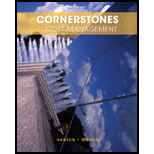
1.
Compute the cost of inputs for the profile 2015, if there is no change from productivity profile 2014 to 2015.
1.
Explanation of Solution
Productivity measurement: The productivity measurement refers to the quantitative assessment of the changes in the productivity.
Profile measurement and analysis: The profile measurement and analysis refers to the computation of a set of operational partial productivity measures and their comparison to the corresponding set of base period, for the assessment of the nature of changes in productivity.
Calculate the cost of inputs for the profile 2015:
| Particulars | Amount ($) |
| Cost of labor (3) | $1,260,000 |
| Cost of materials (4) | $6,300,000 |
| Total PQ Cost | $7,560,000 |
Table (1)
Working Notes (1):
Compute the base period productivity ratios for profile 2014:
Compute the Labor Productivity Profile for 2014:
Working Notes (2):
Compute the Material Productivity Profile for 2014:
The Labor Productivity Profile is 5.00 and Material Productivity Profile is 0.25 for 2014.
Working Notes (3):
Calculate the cost of labor:
Working Notes 4):
Calculate the cost of materials:
2.
Compute the actual cost of inputs for the profile 2015. Indicate the net value of productivity changes and identify the profit change attributable to productivity change of each unit.
2.
Explanation of Solution
Profit-linked productivity measurement and analysis: The profit-linked productivity measurement and analysis is the ascertainment of the amount of change in profit, from the base period to the current period, due to the various changes in the productivity.
Calculate the current cost of inputs for the profile 2015:
| Particulars | Amount ($) |
| Cost of labor (5) | $1,575,000 |
| Cost of materials (6) | $5,250,000 |
| Total Current Cost | $6,825,000 |
Table (2)
Working Notes (5):
Calculate the cost of labor:
Working Notes (6):
Calculate the cost of materials:
Compute the profit linked productivity measure:
| Input | A | C | E | ||||
| Labor | 5 | 90,000 | $14 | $1,260,000 | 112,500 | $1,575,000 | ($315,000) |
| Materials | 0.25 | 1,800,000 | $3.50 | $6,300,000 | 1,500,000 | $5,250,000 | $1,050,000 |
| Total | $7,560,000 | $6,825,000 | $735,000 |
Table (3)
The Net productivity change is $735,000.
The Labor productivity change is ($315,000).
The materials productivity change is $1,050,000.
3.
Compute and describe the price recovery component.
3.
Explanation of Solution
Price-recovery component: The price-recovery component refers to the differences amongst the changes in the total profit with the changed in the productivity effects.
Compute the profit linked productivity measure:
| Particulars | Profile 2014 | Profile 2015 | Changes Amount ($) |
| Revenues | (7) $10,800,000 | (8) $9,900,000 | (9) ($900,000) |
| Costs | (10) $8,640,000 | $6,825,000 | (11) $1,815,000 |
| Total Profit | $2,160,000 | $3,075,000 | (12) $915,000 |
Table (4)
Working Notes (7):
Calculate the Revenues for Profile for 2014:
Working Notes (8):
Calculate the Revenues for Profile for 2015:
Working Notes (9):
Calculate the changes in revenues:
Working Notes (10):
Calculate the cost of inputs for Profile 2014:
Working Notes (11):
Calculate the changes in cost of inputs:
Working Notes (12):
Calculate the changes in total profit:
Compute the Price-recovery component:
The Price-recovery component is $180,000.
Want to see more full solutions like this?
Chapter 15 Solutions
Cornerstones of Cost Management (Cornerstones Series)
- Expert please given correct answer with accountingarrow_forwardLCD Industries purchased a supply of electronic components from Entel Corporation on November 1, 2024. In payment for the $25.3 million purchase, LCD issued a 1-year installment note to be paid in equal monthly payments at the end of each month. The payments include interest at the rate of 24%. Required: 1. & 2. Prepare the journal entries for LCD's purchase of the components on November 1, 2024 and the first installment payment on November 30, 2024. 3. What is the amount of interest expense that LCD will report in its income statement for the year ended December 31, 2024? Note: Use tables, Excel, or a financial calculator. (FV of $1, PV of $1, FVA of $1, PVA of $1, FVAD of $1 and PVAD of $1) > Answer is not complete. Complete this question by entering your answers in the tabs below. Req 1 and 2 Req 3 What is the amount of interest expense that LCD will report in its income statement for the year ended December 31, 2024? Note: Round intermediate calculations and final answers to the…arrow_forwardHiarrow_forward
- Principles of Accounting Volume 2AccountingISBN:9781947172609Author:OpenStaxPublisher:OpenStax College
 Cornerstones of Cost Management (Cornerstones Ser...AccountingISBN:9781305970663Author:Don R. Hansen, Maryanne M. MowenPublisher:Cengage Learning
Cornerstones of Cost Management (Cornerstones Ser...AccountingISBN:9781305970663Author:Don R. Hansen, Maryanne M. MowenPublisher:Cengage Learning Excel Applications for Accounting PrinciplesAccountingISBN:9781111581565Author:Gaylord N. SmithPublisher:Cengage Learning
Excel Applications for Accounting PrinciplesAccountingISBN:9781111581565Author:Gaylord N. SmithPublisher:Cengage Learning  Managerial AccountingAccountingISBN:9781337912020Author:Carl Warren, Ph.d. Cma William B. TaylerPublisher:South-Western College Pub
Managerial AccountingAccountingISBN:9781337912020Author:Carl Warren, Ph.d. Cma William B. TaylerPublisher:South-Western College Pub EBK CONTEMPORARY FINANCIAL MANAGEMENTFinanceISBN:9781337514835Author:MOYERPublisher:CENGAGE LEARNING - CONSIGNMENT
EBK CONTEMPORARY FINANCIAL MANAGEMENTFinanceISBN:9781337514835Author:MOYERPublisher:CENGAGE LEARNING - CONSIGNMENT Essentials of Business Analytics (MindTap Course ...StatisticsISBN:9781305627734Author:Jeffrey D. Camm, James J. Cochran, Michael J. Fry, Jeffrey W. Ohlmann, David R. AndersonPublisher:Cengage Learning
Essentials of Business Analytics (MindTap Course ...StatisticsISBN:9781305627734Author:Jeffrey D. Camm, James J. Cochran, Michael J. Fry, Jeffrey W. Ohlmann, David R. AndersonPublisher:Cengage Learning





